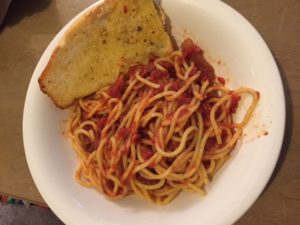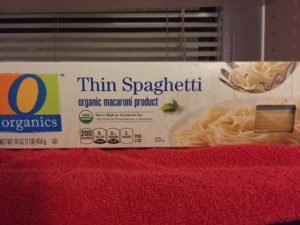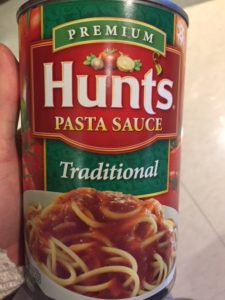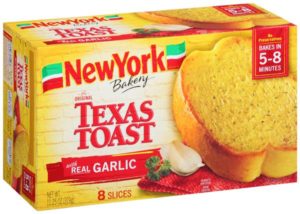
Have you ever been asked as a kid, “If you had to choose one food to eat for the rest of your life, what would it be?” Most children and adults for that matter would say Pizza. My answer has always been Spaghetti and Meatballs. I have chosen this as my Final Project Cookbook Entry, as this is my favorite food in the entire world. I love making it, eating it, and finding new ways to experiment with it. It’s one of those dishes that can be made differently by each individual. When I was child, this was made by my mom as a reward for good behavior. As I grew older into my teens, it was always made on my birthday or when I got high grades. As an adult, I have found that this is typically made to persuade me to come back home and visit. Coincidently, I also have five other siblings and unfortunately none of them like spaghetti even a little. Therefore when Spaghetti was made in our house, everyone knew it was especially made for me. This made me feel special and I think actually made me enjoy it more.
The Italian translation of Spaghetti is Spaghetto and diminutive of spago cord. The actual definition means ‘thin string” or “twine.” Spaghettoni is thicker spaghetti and Spaghettini is a thinner form that would take less time to cook. Typical spaghetti noodles are defined as long, thin, and cylindrical pasta. In our modern era, there is now a variety of more than 50 different types of noodles. Here are a few examples of similar pastas used: Capellini also known as ‘Angel Hair’ (fine, long, and thin noodles), Pappardelle (wide egg noodle), Fettuccine (thick ribbon-like), Fideo (thin but short strands and at a curve), Lasagne (wide and flat), Fusilli (long and spiral shaped), Bucatini (long, thick and hollow inside), Linguine (long, flat, and thin -closely to Fettuccine), Mafalda (flat, wide, more narrow lasagna), and Manicotti (medium, hollow, and rigid). All of these are also cooked the same way as spaghetti noodles, being boiled in water.
Spaghetti Noodles are made with water and wheat that has been milled (we use flour more commonly). The noodles were allegedly brought to Italy from China by Marco Polo (another article noted Arab geographer, Idris) in the late 12th century. They have been specifically originated from the Italian island of Sicily. Normally the dough can be made with a rolling pin and a knife; however modern era has made this simpler with a pasta machine. This is typically dried out afterwards until ready to be cooked. Nowadays most people buy there pasta noodles already dried and packaged from the grocery store. Pasta can interestingly enough last for years, based upon the preparation method or how it was stored (ex. shelf, frozen, etc).Also depending on the thickness of the pasta, will determine how long the pasta will need to be cooked. Angel hair is one of the faster cooking pasta that only takes approximately ten minutes.

The second main ingredient is Marinara sauce. Marinara sauce is made from tomatoes, onions, garlic, and herbs. Luckily there are many more variations of sauce, as it is based upon one’s owns preferences. Even though there is some speculation, this supposedly originated in Southern Italy in both Naples and Sicily. Marinara also means ‘in the style the sailor’s make” in Italian. Although there is no seafood incorporated with Marinara sauce; there are theories found that this derived from items that sailor’s transported. Items such as dried herbs, garlic, tomato paste, and oil were all substances that wouldn’t spoil as easy; and could be prepared quickly for meals on the sea. In addition, dried noodles were also items that could last a long time without expiring. The tomato sauce itself consists of actual crushed tomatoes, the residual juices, olive oil, salt, herbs (ex.bay leaf, oregano, and thyme), sautéed onions, and garlic. This creates a nice tomato paste and/or spread.

One of the components that I later decided was imperative to my spaghetti was the meatballs. The original Italian Meatball is called a Polpette “big meatball”, usually made from beef or veal. When Italian immigrants came to America in 1880-1920, they also began utilizing pork sausage as a meat for the balls. They also normally contain parsley, eggs, and garlic. Aside from traditional pan grilled meat, this was traditionally cooked in an oven on a sheet and/or baking paper. Although in America it is served in tomato sauce; there are also dishes that have it served by itself fried with a small piece of cheese in the center. Some alternative ways of making meatballs would be steaming and braising. Most Italian restaurants now serve meat in Spaghetti in shaped balls (golf ball size), patties, or ground up within the sauce.

I would definitely say that learning to make Spaghetti in the beginning was a small struggle when I was younger. I could never get the noodles cooked and my sauce was never that tasty. With enough practice and developing my own style, I have created the perfect combination of spices and flavor. After researching Spaghetti, I also found that Spaghetti provides nutrition such as carbohydrates, protein, iron, fiber, potassium, and Vitamin B.
My process of making spaghetti begins with placing water in a large pot with a high flame. Once the water begins boiling, the pasta noodles are placed within the pot and brought to a medium flame. I prefer angel hair pasta (normally 25-30cm long) and like to break it in half before putting in the water. I find it easier to eat this way when twirling with my fork. I also normally put a dash of salt in the water and stir to keep the pasta from sticking together. After the pasta has been boiling for approximately eight to ten minutes, it needs to be checked to make sure it loose and fully cooked. I was once told to throw a noodle against the wall and if it sticked, then it was done. I still use this method today and it actually works Once the noodles are done, they need to be strained with a colander (I usually leave in the sink) and/or put in a bowl. I set this aside why I simultaneously begin preparation for the meat sauce.
Now to make the sauce, there will need to be quite a few ingredients to begin: tomato sauce, salt, pepper, garlic, mushrooms, and ground beef. First the meat needs to be cooked in a pan. I prefer ground beef with the lowest amount of fat (my dad used turkey meat as a kid). I usually add a little bit of salt and pepper and slowly begin adding the chopped mushroom and minced garlic. Once the beef is done, I add the tomato sauce in and again, add salt and pepper. Sometimes if I want to make it a little spicier, I add jalapeno juice or Sriracha sauce. Once the sauce is nice and stirred, I pour the sauce over the noodles and garnish with parmesan cheese. I occasionally like to eat my spaghetti with garlic bread on the side as well (Texas Toast is the best).

Spaghetti has not only been a staple in Italian cuisine, but also a representation of love in my life. I always prepare this for my family and friends, as it’s my own signature of food. I had the pleasure of going to Rome, Italy last year and enjoying a plate of pasta. I found it so completely different from any Spaghetti I’ve have thus far, but nonetheless it was delicious. Moving forward, I will continue to experiment and make this a tradition with my own kids. I also found this project to be enlightening, as I’ve never actually researched Spaghetti before and found the information very interesting. Spaghetti and Meatballs is an iconic Italian dish but has become a common American cuisine.
Citations
. “Spaghetti.” Wikipedia, The Free Encyclopedia. Wikipedia, The Free Encyclopedia, 15 Oct. 2016. Web. .7 Dec. 2016.
“Marinara sauce.” Wikipedia, The Free Encyclopedia. Wikipedia, The Free Encyclopedia, 3 Nov. 2016. Web. 7 Dec. 2016.
“Marinara Sauce” the Italian chef. Web 7 Dec 2016
Gangi, Roberta. “Was Spaghetti Invented in Sicily.” Best of Sicily Magazine.2002. Web.7 Dec 2016
“Italian Meatball Variations, Recipes and Serving Style.” Polpette: The Italian Meatball, 23 Aug 2014. Web 7 Dec 2016
“Pasta is not originally from Italy.” Today I Found Out: Feed your brain, 3 Jun. 2011. Web 7 Dec.2016
Waggoner, Susan. Marinara Sauce: The Sauce that Shook the World. fork + plate. 28 Jan 2016 Web.7 Dec 2016
“Meatball.” Wikipedia, The Free Encyclopedia. Wikipedia, The Free Encyclopedia, 4 Dec. 2016. Web. 7 Dec. 2016
Esposito, Shaylyn. “Is Spaghetti and Meatballs Italian?”Smithsonian.com.6 Jun 13. Web 7 Dec 2016
“History of Spaghetti and Pasta.” History of Spaghetti. Web 7 Dec 2016
